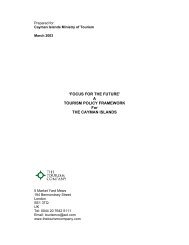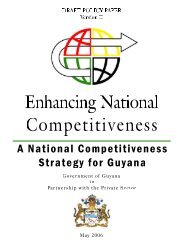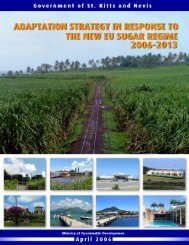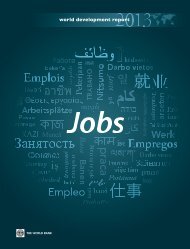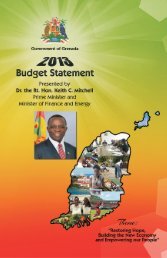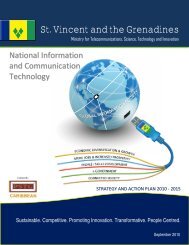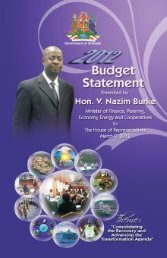Business Removing
Doing Business in 2005 -- Removing Obstacles to Growth
Doing Business in 2005 -- Removing Obstacles to Growth
- No tags were found...
Create successful ePaper yourself
Turn your PDF publications into a flip-book with our unique Google optimized e-Paper software.
38 DOING BUSINESS IN 2005<br />
What to reform?<br />
Land reforms can be highly political and take years. But<br />
the ease of registering property can be improved with<br />
some simple steps. Here are 4 ways to start:<br />
• Simplify and combine procedures for registering<br />
property.<br />
• First link, then unify the agencies involved.<br />
• Provide easier access to the registry.<br />
• And a warning: don’t regard technology as a panacea.<br />
Countries with the fastest time to register property<br />
also have the fewest procedures, without sacrificing due<br />
diligence. Most simply combine steps at the registry,<br />
rather than require the entrepreneur to go to 7 different<br />
agencies, as in Ethiopia and Tanzania, or 3 separate<br />
agencies to pay taxes, as in the Philippines. In Chile the<br />
registry checks for payment of taxes, rather than require<br />
the entrepreneur to go to the tax agency to get a tax<br />
clearance certificate—as in Bolivia, Brazil and Paraguay.<br />
In Cambodia the registry automatically forwards the notification<br />
of registration to the municipality, rather than<br />
add an extra step in the process—as in El Salvador and<br />
Kyrgyz Republic. And in two-fifths of countries the entrepreneur<br />
can pay the stamp duty at the registry when<br />
applying, rather than make a separate trip to the tax<br />
agency, bank or municipality.<br />
A related reform is to link or unify the property registry<br />
and cadastre. By doing so it is easier to detect overlapping<br />
and duplicate titles, saving time in due diligence<br />
and improving the security of property rights. Controlling<br />
for income per capita, countries with unified agencies<br />
score significantly higher on the ease of registering<br />
property. Lithuania unified its cadastre and property<br />
registry in 1997, as well as the separate land and building<br />
registries. It is now unifying all this with other important<br />
public registries—such as addresses and legal entities.<br />
Honduras is merging its registry and cadastre.<br />
A first step towards unification is linking the registry<br />
and cadastre. Spain’s 2002 Cadastral Act aims to do just<br />
that, to increase consistency between the two. The same<br />
is happening in Costa Rica—where the registry also has<br />
access to the civil registry’s national database, allowing it<br />
to determine whether the person transferring property is<br />
alive. This has stemmed a flow of transactions in recent<br />
years, when properties of deceased owners were known<br />
to have exchanged hands, apparently with the owner’s<br />
consent. Countries like Croatia and Slovenia, where the<br />
property registry is in the courts and accounts for over<br />
half of the case backlog, may consider as a priority reform<br />
merging the registry with the cadastre. Much like<br />
new business registration, land registration is inherently<br />
an administrative, not adjudicative process, and does not<br />
require a judge’s attention.<br />
Expanding access to information in the property registry<br />
helps owners to be clearly identified, reducing the<br />
transaction costs to determine who owns what and cutting<br />
the need for time-consuming due diligence. But 28<br />
countries restrict access to the property registry, including<br />
Bolivia, Ethiopia, Jordan, Kuwait and Nepal. In Sri Lanka<br />
a notary or lawyer must be used to access the information.<br />
China, the Kyrgyz Republic and Mongolia are all implementing<br />
reforms to improve access to what was previously<br />
restricted information. Countries with the greatest<br />
ease of registering property also provide more information<br />
and make it more accessible to entrepreneurs.<br />
Many countries are embracing new technologies in<br />
property registration. One in 3 have made registration<br />
electronic in the last 5 years, with rich countries leading<br />
the way. This helps in many ways (figure 5.6). Take the<br />
United Kingdom. Its Land Registration Act, the first<br />
major overhaul of land registration since 1925, came<br />
into force in October 2003. The act sets up a new system<br />
of electronic dealing with land, so that the register accurately<br />
reflects land ownership at any given time. The reform<br />
allows users to investigate title to land online, with<br />
the absolute minimum of additional searches, inspections<br />
and inquiries, and to get instantaneous computerized<br />
updates of title. Implementation is not complete<br />
yet, but time to register is already reported to have declined<br />
by 30%.<br />
FIGURE 5.6<br />
Use of technology is associated with more efficiency<br />
Average reduction in time to register property<br />
Computerized<br />
business systems<br />
–51 days<br />
Source: Doing <strong>Business</strong> database.<br />
Electronic<br />
imaging of titles<br />
–15 days<br />
Electronic<br />
registry of<br />
property<br />
rights<br />
–57 days<br />
Electronic<br />
cadastre<br />
–38 days



